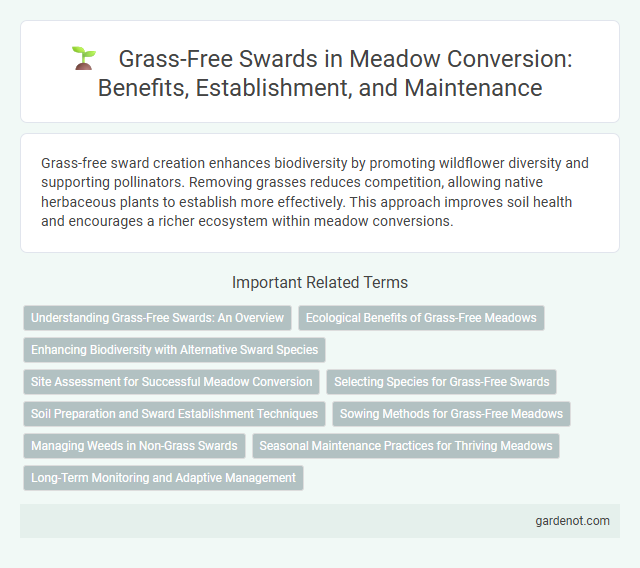Grass-free sward creation enhances biodiversity by promoting wildflower diversity and supporting pollinators. Removing grasses reduces competition, allowing native herbaceous plants to establish more effectively. This approach improves soil health and encourages a richer ecosystem within meadow conversions.
Understanding Grass-Free Swards: An Overview
Grass-free swards consist of plant communities predominantly made up of herbaceous species excluding grasses, often used to enhance biodiversity and support pollinators. These swards improve soil health by increasing organic matter and providing habitat for a diverse range of invertebrates and small mammals. Understanding their composition and management is crucial for successful meadow conversion projects aimed at ecological restoration and sustainable land use.
Ecological Benefits of Grass-Free Meadows
Grass-free swards promote biodiversity by providing specialized habitats for rare wildflowers and pollinators often outcompeted in grass-dominated meadows. These ecosystems enhance soil health through diverse root structures that improve aeration and nutrient cycling. Reduced grass cover also supports ground-nesting birds and beneficial insects, contributing to greater ecological balance and resilience.
Enhancing Biodiversity with Alternative Sward Species
Grass-free sward techniques involve replacing traditional grass species with alternative sward species such as clover, wildflowers, and herbs, which significantly enhance biodiversity by creating diverse habitats for pollinators and soil microorganisms. Incorporating species like red clover and bird's-foot trefoil increases nitrogen fixation and supports a wider range of invertebrates, boosting ecosystem resilience and soil health. These alternative swards contribute to improved meadow conversion outcomes by promoting ecological balance and sustaining local wildlife populations.
Site Assessment for Successful Meadow Conversion
A thorough site assessment is crucial for successful meadow conversion, focusing on soil composition, drainage, and existing vegetation to ensure optimal conditions for establishing a grass-free sward. Evaluating factors such as soil pH, nutrient levels, and sunlight exposure helps determine the suitability of the site and informs tailored management practices. This precise analysis minimizes competition from grasses and promotes the growth of diverse meadow species adapted to the local environment.
Selecting Species for Grass-Free Swards
Selecting species for grass-free swards involves prioritizing native wildflowers and legumes that enhance biodiversity and soil health. Suitable plants like clover, vetch, and bird's-foot trefoil fix nitrogen and improve soil fertility without competing aggressively. Incorporating species with deep root systems supports ecosystem resilience and promotes a diverse, sustainable meadow habitat.
Soil Preparation and Sward Establishment Techniques
Effective soil preparation for grass-free sward conversion involves thorough site clearance, deep ploughing, and soil aeration to eliminate existing vegetation and enhance nutrient availability. Techniques such as applying selective herbicides and using soil improvers like compost or lime optimize soil pH and structure, promoting robust sward establishment. Precise seedbed preparation through fine tilling and firming ensures optimal seed-to-soil contact, facilitating rapid germination and uniform grass-free sward growth.
Sowing Methods for Grass-Free Meadows
Sowing methods for grass-free meadows prioritize the establishment of diverse wildflower species by utilizing techniques such as precision seed drilling and surface broadcasting to minimize grass encroachment. The use of low-nutrient substrates combined with scarification helps improve seed-to-soil contact, promoting successful germination of target species. Implementing native wildflower seed mixes tailored to local soil and climate conditions enhances biodiversity and supports pollinator habitats in grass-free meadow restoration.
Managing Weeds in Non-Grass Swards
Managing weeds in grass-free swards requires precise identification of target species to apply selective herbicides or mechanical removal methods effectively. Maintaining optimal soil fertility and pH levels discourages invasive weeds while promoting the growth of desired non-grass species in meadow conversion projects. Regular monitoring and timely intervention prevent weed dominance, ensuring a balanced, biodiverse sward in grass-free environments.
Seasonal Maintenance Practices for Thriving Meadows
Grass-free sward in meadow conversion requires targeted seasonal maintenance practices to promote biodiversity and soil health. Periodic cutting and removal of biomass during late summer prevent grass dominance, allowing wildflowers and native species to establish. Winter grazing or light trampling enhances seedling survival and nutrient cycling for thriving meadows year-round.
Long-Term Monitoring and Adaptive Management
Grass-free sward restoration requires long-term monitoring to track species composition shifts and soil health indicators, ensuring ecological balance and biodiversity enhancement. Adaptive management techniques, such as periodic disturbance regimes and selective reseeding, optimize sward resilience against invasive grasses and support native flora dominance. Continuous data collection on vegetation structure and environmental conditions enables informed adjustments to management practices, maximizing meadow conversion success.
Grass-free sward Infographic

 gardenot.com
gardenot.com